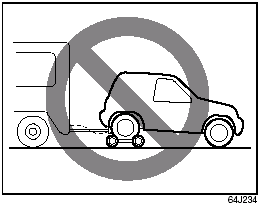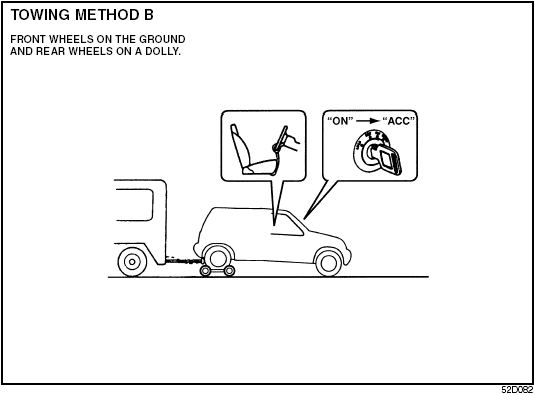Towing Your Vehicle (recreational towing)
Your vehicle may be towed behind another vehicle (such as a motorhome), provided you use the proper towing method specified for your vehicle. The towing method you must use depends on the specifications of your vehicle: whether it is a 2- wheel drive (2WD), 4-wheel drive (4WD) with a transfer switch or 4-wheel drive (4WD) without a transfer switch vehicle.
Use the towing instruction table to select the proper towing method for your vehicle, and carefully follow the corresponding instructions. Be sure to use proper towing equipment designed for recreational towing and make sure that towing speed does not exceed 90 km/h (55 mph).

TOWING INSTRUCTION TABLE
CAUTION:
Never tow your 4WD vehicle without
a transfer switch using recreational
towing methods. If you do, the transmission
will be permanently damaged.
4WD Vehicle With a Transfer Switch


 WARNING:
WARNING:
When you tow your vehicle, follow
the instructions below to avoid accidents
and damage to your vehicle. In
addition, be sure to observe government
and local requirements regarding
vehicle lighting and trailer hitches
or tow bars.
 WARNING:
WARNING:
A safety chain should always be used
when you tow your vehicle.
CAUTION:
Do not tow your vehicle with either
front wheels or rear wheels directly
on the ground (and the transmission
in neutral). If you do, the transmission
will be damaged fatally.

Before towing
Vehicles equipped with a transfer switch may be towed from the front with all four wheels on the ground. Be sure to use proper towing equipment designed for recreational towing and make sure that towing speed does not exceed 90 km/h (55 mph).
To tow a vehicle equipped with a transfer switch with all four wheels on the ground:
1) Turn the ignition key to the “ON” position.
2) Place the transmission in “N” (Neutral) and depress the brake pedal and the clutch pedal fully (if equipped).
3) Use the transfer switch to shift into neutral.

NOTE:
First, push in and turn the switch to the
mark (1) at the left of the “N” position, and
hold the switch in this position for 5 seconds
until the “N” indicator blinks, then turn
the switch to the “N” position.
When you turn the transfer switch to the “N” position, “N” indicator will come on with the buzzer sound.
4) Make sure the “N” light on the instrument cluster comes on.
5) Shift the manual transmission lever into 2nd gear or the automatic transmission lever into “P” (Park).
6) Turn the ignition key to the “ACC” position to unlock the steering wheel.
7) Release the parking brake.
Stop towing the vehicle every 300 km (200 miles). Start the engine. With the manual transmission lever in 2nd gear (or the automatic transmission lever in “D”) and the transfer switch in neutral, rev the engine for about one minute with the clutch engaged (if equipped), to circulate oil in the transfer case.

TOWING METHOD A
4WD Vehicle Without a Transfer Switch



You can not tow your vehicle behind another vehicle using recreational towing methods.
CAUTION:
Never tow your vehicle using recreational
towing methods. If you do, the
transmission will be permanently
damaged.
2WD Vehicle
1) Secure the rear wheels on a towing dolly according to the instructions provided by the dolly manufacturer.
2) Turn the ignition key to the “ACC” position to unlock the steering wheel.
3) Make sure the front wheels are facing straight forward and secure the steering wheel with a steering wheel clamping device designed for towing.
CAUTION:
The steering column is not strong
enough to withstand shocks transmitted
from the front wheels during
towing. Always unlock the steering
wheel before towing.

TOWING METHOD B
See also:
“PASS AIR BAG OFF” Indicator
“PASS AIR BAG OFF” Indicator
The “PASS AIR BAG OFF” indicator is
located on the center of the instrument
panel. When the ignition switch is turned to
the “ON” position, this indicato ...
Manual Heating and Air Conditioning System
Description of Controls
Temperature selector (1)
This is used to select the temperature by
turning the selector.
Blower speed selector (2)
This is used to turn on the blower and to
select blow ...
Sun Visor
The sun visors can be pulled down to block
glare coming through the windshield, or
they can be unhooked and turned to the
side to block glare coming through the side
window.
CAUTION:
When unho ...
